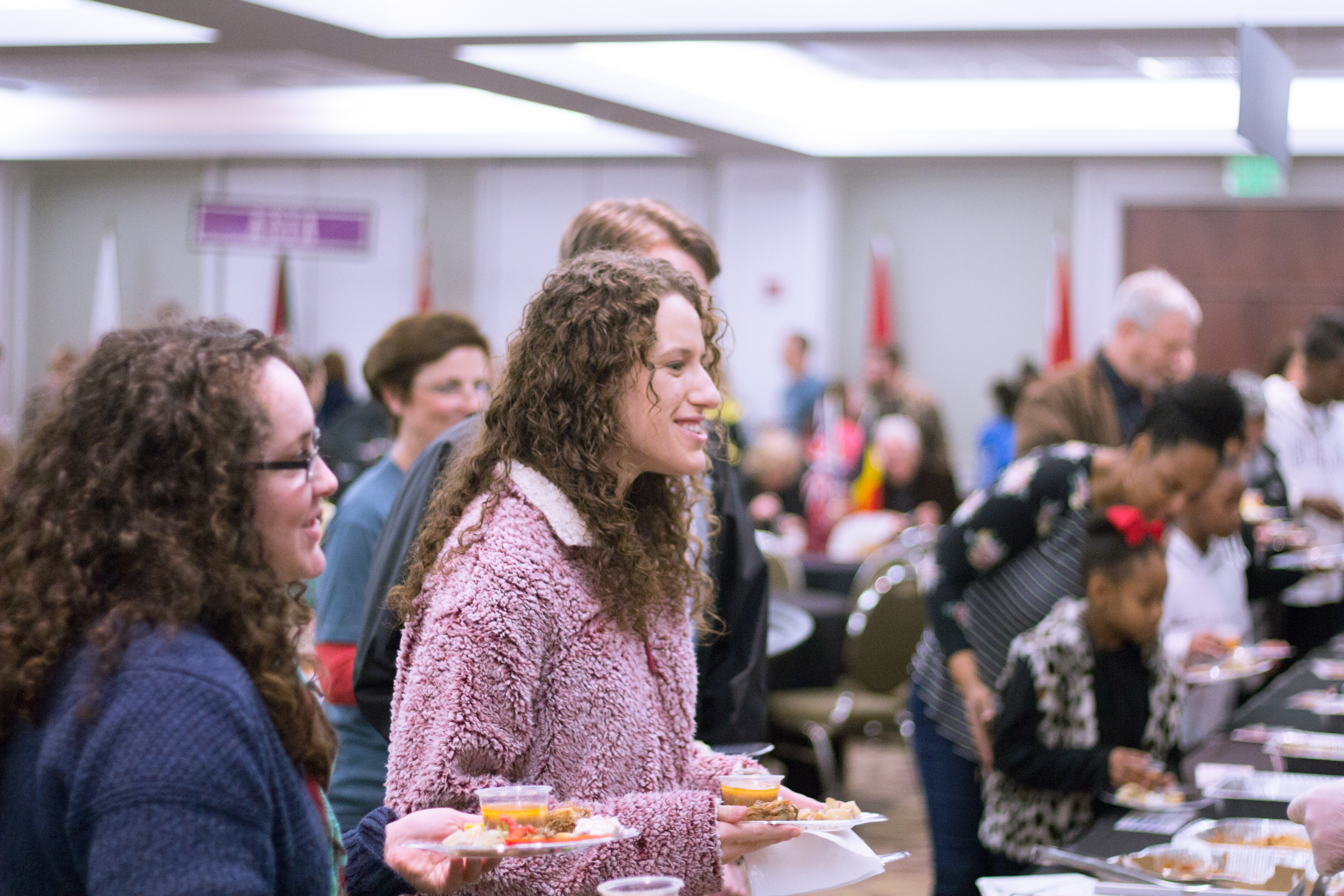
Desegregation: An Honors Seminar
Part 4 of 5
Fifteen honors students contemplated the desegregation of public schools through research on the movement’s early days and trips to key sites in the history of the Civil Rights Movement. The students visited the museum and toured the school at the Little Rock Central High School National Historic Site. Having just read Melba Beals’ Warriors Don’t Cry, the students saw the exterior of the building, where African-American students were initially denied entrance, as well as the cafeteria, hallways and auditorium where the Little Rock Nine persevered through the integration of Central High in 1957.
The honors students researched desegregation in their home towns or in nearby areas and produced portfolios detailing their findings. They also viewed the documentary Hoxie: The First Stand and read Black Like Me, by John Howard Griffin. The one-hour seminar concluded with a trip to the National Civil Rights Museum in Memphis.
In an earlier essay assignment, students were asked to reflect on their visit to Little Rock and on the book by Beals, one of African-American students who integrated Central High amid turmoil and national news coverage in 1957. Five of those reflection papers are listed here. The authors are: Sarah Greeson, a senior from Hot Springs; Jesse Pruett, a senior from Harrison; Kiley Gamble, a junior from McKinney, Texas; Michelle Wasmund, a freshman from Dennison, Texas; and Anna Wakeling, a freshman from Bryant.
Others students in the seminar were: T.J. Bailey, a sophomore from Ft. Smith; Kimberly Carlton, a senior from Brandon, Miss.; Kasa Cooper, a senior from Paragould; Ethan Day, a sophomore from Garland, Texas; Anthony Emerson, a sophomore from Fresno, Texas; Jacob Lively, a senior from Queen City, Texas; Nate Peace, a junior from Bedford, Texas; Jessica Reid, a sophomore from Grandview, Texas; Nolan West, a senior from Bolivar, Missouri; and Clark Whitney, a freshman from Searcy. The course was taught by Dr. Kevin Motl, assistant professor of history, and Dr. Jeff Root, professor of communications and dean of the school of humanities.
Racial Disparity in Beals’s Time and Ours
by Sarah Greeson
“It felt as though we always had a white foot pressed against the back of our necks.” Melba Pattillo Beals penned those words in her 1994 memoir Warriors Don’t Cry. Beals certainly was not the only African American to feel this way, nor was she the last. Throughout United States history, African Americans have been oppressed and openly ridiculed by whites as an inferior minority group. The 13th Amendment abolished slavery in 1865, but it was hardly an end to the discrimination of blacks. The Jim Crow laws (1876-1965) curtailed black freedoms and portrayed them as inferior. The 14th and 15th Amendments were ratified to ensure that all former slaves would be granted U.S. citizenship as well as any rights that other U.S. citizens had, such as voting. In 1954, the U.S. Supreme Court defined racial segregation in public institutions as unconstitutional in Brown v. Board of Education of Topeka, and the process of integrating blacks into all-white public schools such as Little Rock Central began. Our seminar’s reading of Warriors Don’t Cry and subsequent visit to Central High School in Little Rock has led me to search myself for prejudices against blacks; what I have discovered is an unsettling mixture of ignorance and mild prejudices to which I was exposed at an early age.
Never before had I realized my own past ignorance and an accompanying emotional weight like the one that came after reading Beal’s memoir, Warriors Don’t Cry. Melba Pattillo Beals is a gut-wrenching example of someone who has endured countless verbal and even physical attacks solely based on the color of her skin. Beals marched among mostly unchartered territory when she became one of nine African American students to integrate into an all-white high school in Little Rock. Her memoir takes the reader through her childhood, which she spent as a student at the Paul Laurence Dunbar High School, a model school for African Americans, and through her memories of ridicule and suffering at an all-white school. As I read scenes in which Melba was spit on, thrown acid on, or threatened with death, I realized that my childhood and education starkly contrasts from Melba’s. Civil rights aside, I have not spent the last seventeen years as a student who treasures my education, daily counting it as a gift. Instead, I have most often held a sense of entitlement over my education. Melba, on the other hand, fought for a good education. When the opportunity came for her to volunteer to integrate into Little Rock Central, she did. Even as a thirteen-year-old, Melba noticed that races were separated, that her school only taught African Americans like her. Melba’s initial dream for being part of mixing whites and blacks in an educational setting came after visiting family in Cincinnati: “I couldn’t stop hoping that integrating Central High School was the first step to making Little Rock just like Cincinnati, Ohio” (32). She saw that integration had occurred in some places but not in her hometown.
It seems that prejudices are most often taught by family members and closely surrounding friends. Melba’s family did not plant in her a desire to hold grudges against whites even after she was enrolled in Central High School, where whites were hateful and violent toward her. She remembered when her father was turned away at the grocer and how it affected her: “Until that moment, I had thought [my father] could take on the world, if he had to protect me. But watching him kowtow the grocer made me know it wasn’t so.” Instead of reconvening with family every afternoon and bottling up anger toward those who mistreated her, Melba consistently turned the other cheek. She battled with grace. Her grandmother poured wisdom into her with sayings such as, “You don’t want to be white, what you really want is to be free, and freedom is a state of mind” and, “That’s the reason God spared your life. You’re supposed to carry this banner for our people” (6,3). Despite the racism that was shot at Melba, she did not return the hatred.
Like Beals’s family, mine did not whisper blunt words of racism into my ear. I was never brought to question whether or not whites and blacks are equal. The Bible makes clear that every human being was created by God for a distinct purpose, and we are all sinful and in need of redemption that only comes from Jesus Christ, and I have been brought up to believe that. Beyond being brought up to believe it, I have questioned and probed these claims on my own, and I wholeheartedly believe them to be true. However, the taboo topic of romantic relationships between blacks and whites was tiptoed around plenty of times during my childhood. I specifically remember one Sunday school question that my close friend Kirby posed to our teacher in the sixth or seventh grade: “Why is it wrong for white people to marry black people?” Our teacher, a middle-aged white lady, sat dumbfounded before muttering a vague and unhelpful, “It just shouldn’t happen.” Years later, when I moved into Ouachita as a freshman and was assigned a room with a white girl whom I had never met, I soon found out that my roommate was dating an African American from her hometown. When she placed a picture frame of the two of them on her desk as we were decorating our room, I remember feeling a sharp twinge of judgment that I never voiced. That memory stings me.
Most of the time I do not consciously think about a person’s skin color when conversing with them. However, I admit that I have been largely oblivious to the idea that African Americans perhaps feel less a part of society than I, a Caucasian, do. Whether I am at Ouachita or at home in Hot Springs, the vast majority of people around me have white skin. I have never attended a school in which I was the minority. Before coming to Ouachita, I attended to the same public high school in Hot Springs for thirteen years. Out of my graduating class of a slightly more than two hundred, there were no more than ten African American students, and another ten students may have been of other minority groups. Out of the seven public schools in the Hot Springs area, only one has a majority of African American students. I never gave a second thought to the fact that the minority students in my school probably feel fish out of water much of the time. Pattillo’s memoir, our class’s field trip to Little Rock Central High School, our guest speaker, Mr. Bagley, and our class discussions have opened my mind to the reality that blacks and whites, in many places and in many situations, are not yet equal. Whites still have the upper hand simply by being the majority group. After reading Warriors Don’t Cry, I am now convinced that the few African American kids with whom I attended school could have been bullied and treated differently by others because of their skin color. If so, I was oblivious. When I was in elementary school in the early nineties, were children turned away from playing on the merry-go-round because of their black skin like Melba? Melba had to devise a new strategy every day just to survive. Did kids at my school ever feel like that? Perhaps to a lesser degree, but I venture to say yes.
Our class’s field trip to Little Rock Central High School helped steep my reading of Warriors Don’t Cry in reality. Touring the school and walking up the same entryway and into the same auditorium and cafeteria as the Little Rock Nine gave me an instant connection to the history of integration and, in turn, to the civil rights history of our nation. We learned more about the lives of the Little Rock Nine since their time as the first students to integrate into the school. I found it particularly interesting that none of the nine original African American students reside in Arkansas. I was grateful for the opportunity to learn from a professional guide about the school as it is today, one in which whites are the minority. I also relished the time that the school’s current principal spoke to our group. It was clear that Little Rock Central High is seen as an important institution not only because of its history, but also because of its present successes in the arts and academics.
Every part of me believes that all humans are created equal. That people resolve to treat others as inferior to them, then, illustrates the brokenness of the human race. For a black person to wake up feeling as though he or she is not of the same caliber as a white neighbor regardless of his or her actions is horrific. Such feelings are not of the past; as I have become aware in the past weeks in class, there is much segregation still intact in our communities today. To demonize a minority group simply because there are less of them is wrong and, I venture to say, evil. This evil points straight to the fallen nature of man. Man will put others down so that he may feel superior.
Last week a friend told me about a conversation she had with an African American student on campus. This student confessed to her that being a minority at Ouachita is difficult every day. He often feels detached from the culture here. When she asked what she could do to help, he told her to be intentional about making friends with all types of people on campus. At the same time, though, it could also be arrogant to seek out friendships with African Americans if, again, one does it based on the color of skin. As I think about what we have read, seen, and discussed thus far in class, I realize that racial prejudices and segregation between blacks and whites is still alive. Even more, I have begun to see more of the depth of the hardships that come with racial inequality. I will never fully know it, yet I do not believe the correct response is to feel ashamed about my own ignorance and pity for their hardships. Instead, I will choose to keep cultivating an awareness, to keep learning civil rights history, to be willing to admit my past ignorance and prejudices, and hope to let them go.








